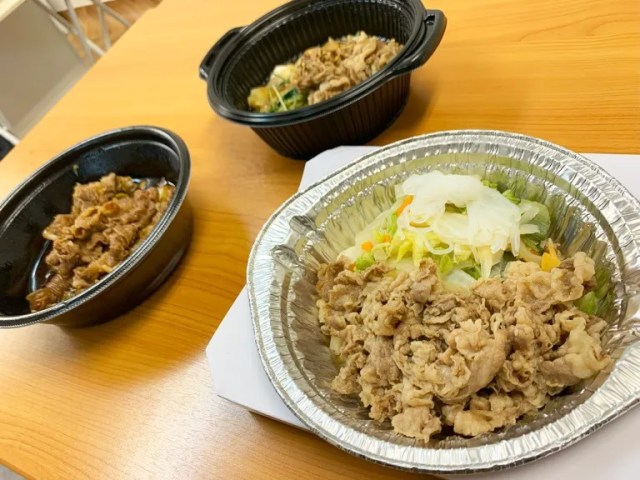
Turns out one wallet-friendly chain’s hot pot has a lot more meat.
We’re entering the best time of the year to eat sukiyaki. That’s not just because the traditional beef hot pot tastes especially good when the weather is cold, but also because late autumn and winter are the most affordable times to eat it.
Ordinarily, sukiyaki is a premium-priced meal choice. Every year in late autumn, though, a number of budget-friendly restaurant chains in Japan roll out their own suikiyaki sets, with the banners advertising the limited-time options appearing around the time the leaves start to change to their fall colors.
▼ Left to right: sukiyaki posters for Sukiya, Yoshinoya, and Yayoiken
For example, right now you can get a sukiyaki hot pot at beef bowl chain Yoshinoya, rival beef bowl chain Sukiya, and casual Japanese restaurant chain Yayoiken, all for less than 1,000 yen (US$6.70). We wondered, though, which chain’s sukiyaki set gives you the most beef, so to find out we picked up one of each and measured their meat content.
▼ Clockwise from top: Yoshinoya, Sukiya, and Yayoiken, with separate containers for the eggs that come with them.
Once we had their tops off, we grabbed a kitchen scale and a plate to weigh them on. Because this is a serious scientific research project, we wanted to ensure maximum accuracy, so we started by weighing the plate itself, determining its weight to be 8 grams (0.28 ounces).
First up was Yayoiken’s Sukiyaki Teishoku (sukiyaki set meal), which is priced at 900 yen for takeout. After transferring all of its beef to the plate, the scale read 67 grams, indicating 59 grams of beef.
Next was Sukiya’s 890-yen Gyusuki Nabe Teishoku (beef sukiyaki hot pot set meal), which tipped the scales at a startling 108 indicated grams, meaning 100 grams of beef!
This was such a big difference that we wondered if the number was being inflated by leftover drippings from the Yayoiken weigh-in, since we were using the same plate. But nope, with all of the beef removed, the plate’s weight was still just 8 grams, meaning that any moisture that had accumulated was having a negligible effect.
And last, it was time for Yoshinoya’s Gyusuki Nabezen (beef sukiyaki hot pot meal), 773 yen for takeout, which had 74 grams of beef.
So per order, you’re getting a lot more beef with Sukiya’s sukiyaki, and it’s also the best value in terms of meet-for-monetary outlay.
● Yayoiken: 15.3 yen per gram of beef
● Sukiya: 8.9 yen per gram of beef
● Yoshinoya: 10.4 yen per gram of beef
In terms of beefiness, Sukiya is an even better deal if you’re eating in, since Yayoiken and Yoshinoya charge slightly more for their eat-in sukiyaki set (950 and 787 yen, respectively) while Sukiya’s is the same price regardless of where you’re eating.
Of course, there’s more to sukiyaki than just the beef, and since we had three servings in front of us, we decided to eat them all and compare how they taste. Out of the three, Yayoiken’s broth is the sweetest and Sukiya’s the saltiest, with Yoshinoya somewhere in between. Their noodles are also slightly different. While they’re all udon, Yayoiken’s are chewier than the others’, and Yoshinoya’s have an interesting texture too, by nature of being flatter than udon noodles usually are.
Honestly, there’s not a bad pick in the bunch, but if you want the most meat, Sukiya is the one to go with.
Photos ©SoraNews24
● Want to hear about SoraNews24’s latest articles as soon as they’re published? Follow us on Facebook and Twitter!
[ Read in Japanese ]